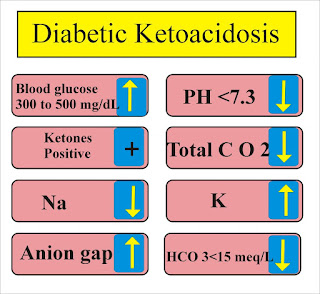Persons at HIGH RISK for diabetes
a) All persons
manifesting any of the following signs and symptoms: polyuria, polydipsia,
polyphagia, weight loss inspite of adequate food intake, undue tiredness and
fatigue etc.
b) All persons with a
family history of diabetes.
c) All obese patients,
especially those with central obesity, waist-hip (W-H) ratio, approx. >0.95
in men and >0.85 in women, and/or a Body Mass Index (BMI) >25.
d) All adult patients
with tuberculosis, atherosclerosis, recurrent infections, high blood pressure
and lipid abnormalities, non- healing ulcers etc.
e) All women with a
bad obstetric history, recurrent fetal wastage, and those who give birth to
large weight babies.
f) Persons who show an
acute rise in the blood glucose levels at time of physical (myocardial
infarction, cerebrovascular accidents, acute infections, trauma, etc.) or
mental stress.
g) Persons taking
drugs which are known to increase blood glucose levels like steroids, thiazide
diuretics, oral contraceptives, beta-blockers, phenytoin sodium, etc.
ALL
PERSONS OVER THE AGE OF 30 YEARS SHOULD UNDERGO AN ANNUAL TEST FOR THE PRESENCE
OF DIABETES.
METHODS:
A. Glycated hemoglobin
(HbA1C) test :
This blood test indicates your
average blood sugar level for the past two to three months. It's also called HbA1c, glycated hemoglobin test,
and glycohemoglobin. It measures the percentage of blood sugar
attached to hemoglobin, the oxygen-carrying protein in red blood cells. The
higher your blood sugar levels, the more hemoglobin you'll have with sugar
attached.
How the Test Works
The sugar
in your blood is called glucose. When glucose builds up in your blood, it binds
to the hemoglobin in your red blood cells. The A1c test measures how much
glucose is bound.
Red blood
cells live for about 3 months, so the test shows the average level of glucose
in your blood for the past 3 months.
If
your glucose levels have been high over recent weeks, your hemoglobin
A1c test will be higher.
What's a Normal
Hemoglobin A1c Test?
For people
without diabetes, the normal range for the hemoglobin A1c level is between 4%
and 5.6%. Hemoglobin A1c levels between
5.7% and 6.4% mean you have a higher chance of getting of diabetes.
Levels of 6.5% or higher mean you have diabetes.
B. Random blood sugar test :
A blood sample
will be taken at a random time. Blood sugar values are expressed in milligrams
per deciliter (mg/dL) or millimoles per liter (mmol/L). Regardless of when you
last ate, a random blood sugar level of 200 mg/dL (11.1 mmol/L) or higher
suggests diabetes, especially when coupled with any of the signs and symptoms
of diabetes, such as frequent urination and extreme thirst.
C. Fasting blood sugar
test :
A blood sample
will be taken after an overnight fast. A fasting blood sugar level less than 100 mg/dL (5.6 mmol/L) is
normal. A fasting blood sugar level from 100 to 125 mg/dL (5.6 to 6.9 mmol/L)
is considered prediabetes. If it's 126 mg/dL (7 mmol/L) or higher on two
separate tests, you have diabetes.
D. Oral glucose tolerance test : For this test, you fast overnight, and the fasting blood sugar level is measured. Then you drink a sugary liquid, and blood sugar levels are tested periodically for the next two hours.
|
Glucose Test |
|||
|
|
Glucose Concentration (mg/100ml) |
||
|
|
Whole Blood |
Plasma |
|
|
|
Venous |
Capillary |
Venous |
|
Diabetes
Melittus |
|||
|
Fasting |
>/=110 |
>/=110 |
>/=126 |
|
2 hours
post Glucose Load |
>180 |
>200 |
>200 |
|
Impaired
Glucose Tolerance |
|||
|
Fasting(If
measured) |
<110 |
<110 |
<126 |
|
2 hours
post Glucose Load |
>/=120
& </=180 |
>/=140
& </=200 |
>/=140
& </=200 |
|
Impaired
Fasting Glycemia |
|||
|
Fasting |
>/=100
& </=110 |
>/=100
& </=110 |
>/=110
& </=126 |
|
2 hours
PG (If measured) |
<120 |
<140 |
<140 |
A blood sugar level less than 140 mg/dL (7.8 mmol/L) is normal. A reading between 140
and 199 mg/dL (7.8 mmol/L and 11.0 mmol/L) indicates prediabetes. A reading of
200 mg/dL (11.1 mmol/L) or higher after two hours may indicate diabetes.












